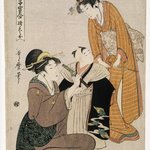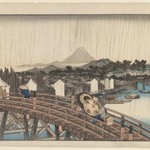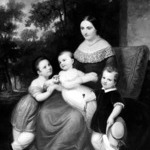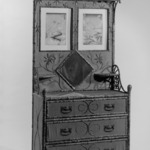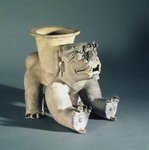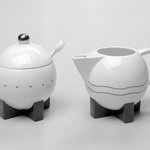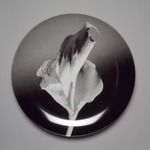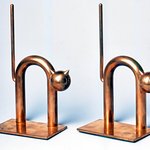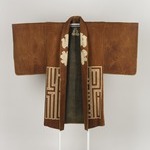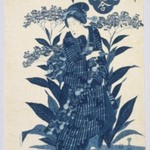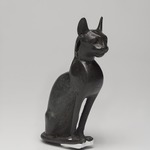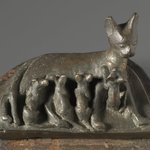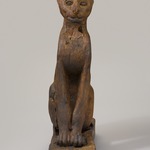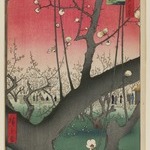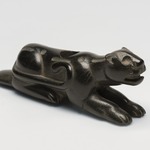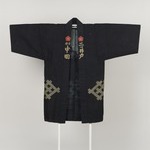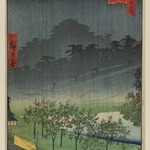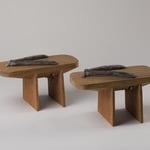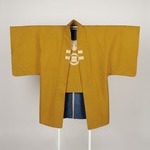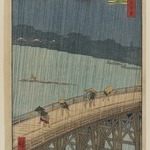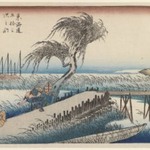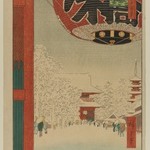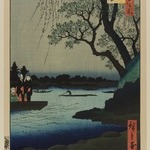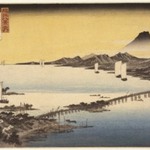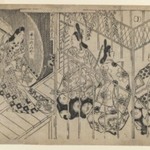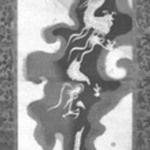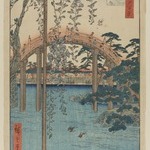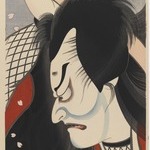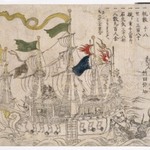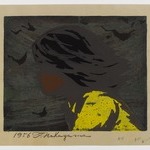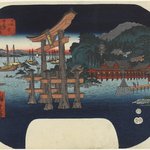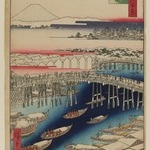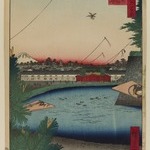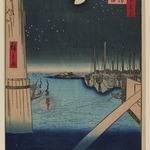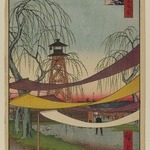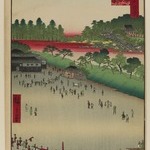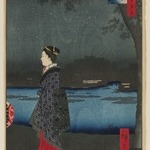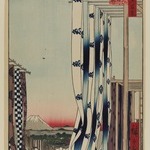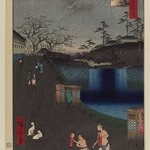
Asakusa Ricefields and Torinomachi Festival, No. 101 from One Hundred Famous Views of Edo
Utagawa Hiroshige
Asian Art
Hiroshige here presents the Yoshiwara pleasure quarters on the single busiest day of the year. However, from the second story of a brothel, the noise and activity seems far away. In the distance, crossing the Asakusa Ricefields, is a procession celebrating the Torinomachi Festival. On this day, the Yoshiwara was open to everyone, including ordinary women. It was also a monbi, one of the special days on which each courtesan was required by tradition to take a customer—or to pay the fee to the brothel owner if she failed. Casually arranged in the foreground are a courtesan's accouterments. Peeping out from behind the border of a screen are tissue papers delicately known as "paper for the honorable act."
MEDIUM
Woodblock print
DATES
11th month of 1857
PERIOD
Edo Period, Ansei Era
DIMENSIONS
Sheet: 14 3/16 x 9 1/4 in. (36 x 23.5 cm)
Image: 13 3/8 x 8 3/4 in. (34 x 22.2 cm) (show scale)
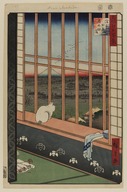


MARKINGS
Censor: Aratame seal.
Date seal: Snake II, Eleventh Month, 1857.
(Date and censor seal at top margin).
Publisher: Shitaya Uo Ei/Shitaya Noei.
SIGNATURE
Hiroshige-ga, lower left
COLLECTIONS
Asian Art
ACCESSION NUMBER
30.1478.101
CREDIT LINE
Gift of Anna Ferris
PROVENANCE
Prior to 1930, provenance not yet documented; by 1930, acquired by Anna Ferris of Summit, NJ; 1930, gift of Anna Ferris to the Brooklyn Museum.
Provenance FAQ
CATALOGUE DESCRIPTION
This image offers a view from the second story of a Yoshiwara brothel over the Asakusa Ricefields, toward a dense procession of visitors to the Torinomachi Festival, held at Washi Daimyojin Shrine (to the right - not seen here). The god of this shrine is an eagle (washi), popular among those in the entertainment trades. Particularly popular during the festival were "kumade," bamboo rakes decorated with symbols of prosperity offered at the many stalls in and around Washi Shrine. It was the only time ordinary women were allowed to enter the gates to the Yoshiwara. It was also a "monbi," a special day on which each courtesan was required by tradition to take a customer, or pay the fee to the brothel owner if she failed. It was the single busiest day of the year in the Yoshiwara. This scene shows the room of a courtesan who has just had an afternoon customer. He probably brought her as a gift the set of "kumade" hairpins, one of which has been pulled out and admired. On the window sill is a mouth-rinsing bowl and a used towel; to the left is the border of a folding screen decorated with a bird motif, and just above the hairpins is a parcel of tissue papers delicately known as onkotogami, or "paper for the honorable act." In the foreground is an exquisitely detailed cat.
EXHIBITIONS
MUSEUM LOCATION
This item is not on view
CAPTION
Utagawa Hiroshige (Japanese, 1797–1858). Asakusa Ricefields and Torinomachi Festival, No. 101 from One Hundred Famous Views of Edo, 11th month of 1857. Woodblock print, Sheet: 14 3/16 x 9 1/4 in. (36 x 23.5 cm). Brooklyn Museum, Gift of Anna Ferris, 30.1478.101 (Photo: Brooklyn Museum, 30.1478.101_PS20.jpg)
IMAGE
overall, 30.1478.101_PS20.jpg. Brooklyn Museum photograph, 2023
"CUR" at the beginning of an image file name means that the image was created by a curatorial staff member. These study images may be digital point-and-shoot photographs, when we don\'t yet have high-quality studio photography, or they may be scans of older negatives, slides, or photographic prints, providing historical documentation of the object.
RIGHTS STATEMENT
No known copyright restrictions
This work may be in the public domain in the United States. Works created by United States and non-United States nationals published prior to 1923 are in the public domain, subject to the terms of any applicable treaty or agreement.
You may download and use Brooklyn Museum images of this work. Please include caption information from this page and credit the Brooklyn Museum. If you need a high resolution file, please fill out our online application form (charges apply).
The Museum does not warrant that the use of this work will not infringe on the rights of third parties, such as artists or artists' heirs holding the rights to the work. It is your responsibility to determine and satisfy copyright or other use restrictions before copying, transmitting, or making other use of protected items beyond that allowed by "fair use," as such term is understood under the United States Copyright Act.
The Brooklyn Museum makes no representations or warranties with respect to the application or terms of any international agreement governing copyright protection in the United States for works created by foreign nationals.
For further information about copyright, we recommend resources at the United States Library of Congress, Cornell University, Copyright and Cultural Institutions: Guidelines for U.S. Libraries, Archives, and Museums, and Copyright Watch.
For more information about the Museum's rights project, including how rights types are assigned, please see our blog posts on copyright.
If you have any information regarding this work and rights to it, please contact copyright@brooklynmuseum.org.
RECORD COMPLETENESS
Not every record you will find here is complete. More information is available for some works than for others, and some entries have been updated more recently. Records are frequently reviewed and revised, and we welcome any additional information you might have.
